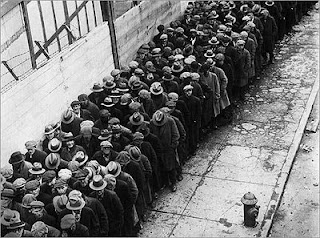Topher Morrison
PurpleSerf.com |
| We rarely see these lines anymore because America brings the soup kitchen to your doorstep. Image Source:BlogCritics.org by J.M. Harrison. |
The Great Depression was easy to accept, why? Because the lines were clear to see, today they are hidden from view. As Republicans and Democrats square off over what to cut, the 47 year old food stamp program finds itself in peril and for good reason.
The Wall Street Journal reported last May that a shocking 1 in 7 Americans were claiming food stamp benefits. In states like Oregon and Mississippi the numbers were an abysmal 1 in 5 while states like Wyoming featured only 6% of their citizens relying on government assistance. If 1 in 7 Americans are struggling to eat why isn't this alarming and obvious to mainstream America?
 |
| This is an example of the new and improved EBT system. No more lines, no more hassle; benefits streamlined! Image Source: eHow.com by Joe Raedle at Getty Images. |
Today "poor" Americans, those within 130% of the poverty level (currently $22,350 for a family of 4), are eligible to receive electronic benefit transfer (EBT) cards in the mail and are loaded automatically. There is no need to walk down to the local family or health services office - no lines, no hassle, no stigma, but importantly little effort. Hence, out of sight is out of mind, at least when it comes to most Americans and realizing that our nation is suffering from a growing dependency on government assistance.
The United States Department of Agriculture (USDA) is responsible for administering the food stamp program now officially called the Supplemental Nutrition Assistance Program (SNAP) and on top of the staggering number of dependents, the cost of the program has metastasized. Traditionally over budget, inelastic to demand (requiring Congress to approve budget increases every year) and now accounting for 67% of the USDA's budget (up from just 27% in 1980) the program, regardless of constant adjustments, reorganization and new snappy names, is a demonstrable failure.
There is no doubt SNAP relieves those struggling to eat, but don't you every wonder how Americans ever made it this far without food stamps? The program wasn't there during our greatest time of need, the Great Depression, so how did we make it this far? If the story of Leroy Fick, a millionaire still receiving food stamps, has anything to offer it is that there is a massive disconnect between the federal government and the people in need.
Revolutionary solutions require operating within new revolutionary paradigms.
While the Food Action Research Center and Moody's Analytics contend that food stamps are the most effective forms of economic stimulus, credited for increasing economic activity by $1.73 for every dollar spent, questions still abound. Is the USDA, an agency envisaged to regulate US agricultural production, meant to stimulate the economy? Is it more important to feed a man or teach him how to feed himself? Can the states, churches, charities, NGOs, and individuals do a better (a more cost effective, responsive and responsible) job at feeding the needy?
 |
| Created in 2003 with 3 gardens and a pamphlet Urban Farming has created over 43,000 ways of teaching modern America how to feed themselves once again. |
The integration of rural and urban lifestyles may be a few years off (urban farming on Facebook for example only has 3,706 fans as of this post), however, given our current debt crisis, a massive impetus to shed archaic and inept systems of government charity and an opportunity to emancipate ourselves from the idea aid can only come from the federal dole cutting edge ideas can and will be given room to grow. Imagine:
 |
| Greenhouses no longer need to be relegated to the countryside, but can now be brought indoors and engineered to produce far more than we ever dreamed. Image Source: Ecofriend.com |
 |
| Allowing scientists, engineers, farmers, and charities to work together human ingenuity can achieve unknown possibilities. Image Source: Sharkride.com |

No comments:
Post a Comment